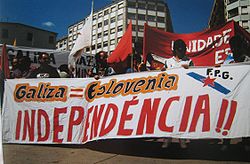Galician independence movement
 From Wikipedia - Reading time: 9 min
From Wikipedia - Reading time: 9 min
This article needs additional citations for verification. (July 2016) |
You can help expand this article with text translated from the corresponding article in Galician. (July 2021) Click [show] for important translation instructions.
|

The Galician independence movement (Galician: movemento de independenza galego) or the Galician separatist movement (Galician: movemento separatista galego) is a political movement derived from Galician nationalism that supports the independence of Galicia and the other Galician-speaking territories outside the Autonomous Community of Galicia, including As Portelas, O Bierzo, and the Eo-Navian lands (which are collectively known as Galicia irredenta) from Spain.
History
[edit]Initiation
[edit]The first realization was the organized political committee Comité Revoluzonareo Arredista Galego, formed by Fuco Gomez in Cuba in the 1920s, but during the Second Spanish Republic did not have much significance. In Argentina there was an association called Sociedade Nazonalista Pondal, active mostly in the 1930s.
Republic of Galicia
[edit]In 1931, Galicia declared its independence. The next day, Galicia rejoined Spain.
Franco and the 1970s
[edit]
With the beginning and spread of several mass movements of protests in 1968, including various regions and cities of Spain united against Francisco Franco's regime, the Francoist dictatorship of Spain repressed the protests and strikes in the country using police brutality and state violence.[1] In the 1970s, a sector of the Galician People's Union near of Moncho Reboiras tried to organize a rebel group against the Francoist dictatorship of Spain following the model of ETA, but ended with the murder of Reboiras. In 1978, a sector of the Galician People's Union was split, constituting first the Galician People's Union-Proletarian Line and later the Galician Party of the Proletariat, with secessionist character.
Galician independentism at present
[edit]In 1986 the Communist Party of National Liberation, a secessionist splinter of the Galician People's Union, was expelled from the BNG for having supported the candidacy of Herri Batasuna during the Elections to the European Parliament. Beside the Galiza Ceive-OLN (the new name of the organization) and several secessionist groups, they formed the Galician People's Front the following year, which has been the main Galician secessionist organization since then.
In that context appeared the Exército Guerrilheiro do Povo Galego Ceive, which carried out 90 terrorist actions in six years, the last one on 13 of September, 1991. As consequence two activists, a civil guard and a girl died. Several dozens of supposed members were arrested.
Ten members of Assembleia da Mocidade Independentista and other groups were held in 2005 and two of them were strongly suspected of having placed a bomb in an automatic cash dispenser in Santiago de Compostela. That same year the existence of a group named Resistência Galega, which has claimed responsibility for several bomb attacks, was made public.
The BNG, the major nationalist/secessionist political party, has 25 of the 75 seats in the Galician Parliament.
Pro-independence public figures
[edit]- Xose Manuel Beiras, politician.
- Xosé Luís Méndez Ferrín, writer, candidate to the Nobel Prize of Literature in 1999, ex-president of the Royal Galician Academy and member of the Galician People's Front.
- José Ignacio Fernández Palacios, ex-football player.
- Alfonso Daniel Rodríguez Castelao, Galician politician, writer, painter and doctor.
- Camilo Nogueira Román, politician.
- Rosalia de Castro, Galician romanticist writer and poet.
- Ricardo Carvalho Calero, father of the reintegrationist movement, founder of the Galician Association of Language and writer.
- Uxío Novoneyra, poet, journalist and writer of children's literature.
- Teresa Moure, writer and feminist. She lectures in Linguistics at the University of Santiago de Compostela.
- Lois Pereiro, poet.
- Rafa Villar, writer, activist of the Nunca Máis movement and town councillor in Santiago de Compostela.
- Milladoiro, folk and Celtic music band from A Coruña.[citation needed]
- Ricardo Flores Peres, political activist.
References
[edit]- ^ Casanellas, Paul (May 2022). "Joint Efforts in the Fight against Franco: Protest and Repression during the Spanish Long '68". Contemporary European History. 31 (2). Cambridge and New York: Cambridge University Press: 271–285. doi:10.1017/S0960777321000163. ISSN 1469-2171. LCCN 92660049. OCLC 237351536. S2CID 246301760.
 KSF
KSF